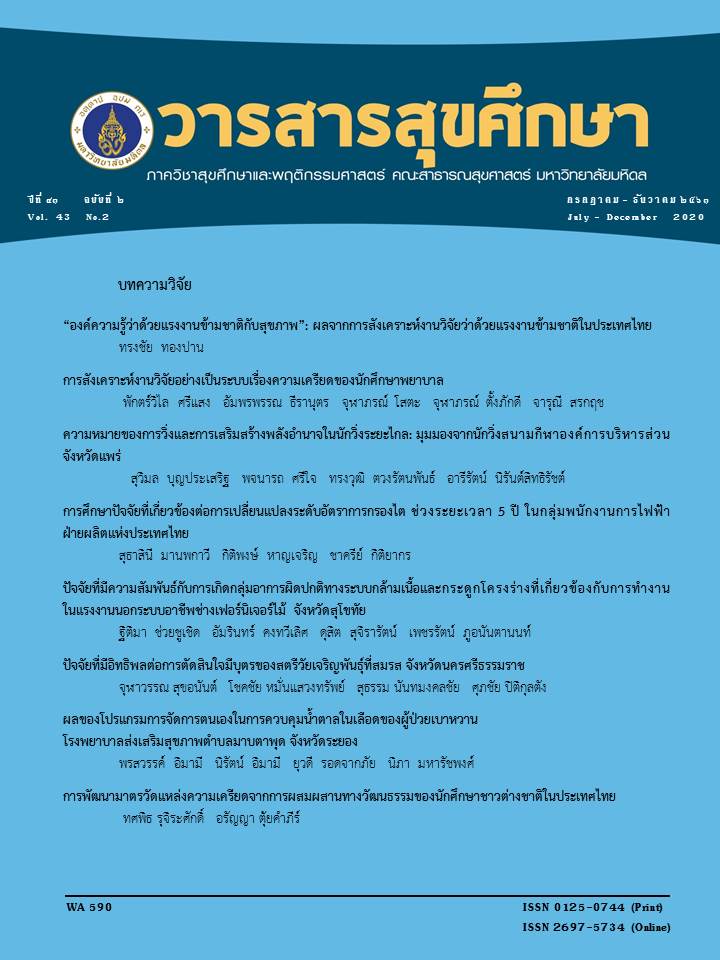Effects of The Smoking Cessation Program Applying Self-Efficacy and Social Support on Risk Group of Cardiovascular Disease at Surat Thani Province
Main Article Content
Abstract
Smoking is high risk behavior to non-communicable diseases (NCD) especially stroke that kills many smokers. This quasi-experimental design, two groups with pretest and posttest design aimed to develop cessation program applying Self-Efficacy Theory and Social Support for helping stroke patients in Surat Thani province to Quit smoking. This research was in 24 experimental samples and 35 comparison samples. Program and activities composed of seven times within 8 weeks which were group activities at week 1, 3 and 7. Then home visit and follow up by researcher and village health volunteer (VHV). Data were collected by interview questionnaire for three times; before experiment, after experiment at the 4th week and follow up period at the 12nd week. Data were analyzed the data difference by Chi – square test, Independent t – test, Paired Sample t – test and Z – test. The results after the experiment showed that the experimental group had mean score of knowledge about cigarette and stroke, self-efficacy of smoking quit, and outcome expectation of smoking quit, higher than before experiment and comparative group significantly (p<0.001). For successful quitter, after the experiment there were 13 quitters (54.17%) and at follow up period quitters have increased to 15 quitters (62.50%). This study recommends that the health education program applying self-efficacy theory and social support can help stroke patients quit smoking effectively so that all level of NCD clinic should routinize this cessation program in their service.
Article Details
References
World Health Organization. About World Heart Day 2014 [Internet]. 2014 [Cited 8 December 2017]. Available from: http://www.worldheartfederation.org/index.php?id=123.
U.S. Department of Health and Human Services (2014). The Health Consequences of Smoking - 50 Years of Progress: A Report of the Surgeon General. Atlanta, Centers for Disease Control and Prevention. National Center for Chronic Disease Prevention and Health Promotion, Office on Smoking and Health.
Contie V, Defibaugh A, Dutchen S, Earl L & Wein H. NIH news in health: Love your heart; take steps to reduce heart risks [Internet]. 2012 [Cited 6 December 2017]. Available from: http://newsinhealth.nih.gov/issue/Feb2012/Featurel.
สำนักโรคไม่ติดต่อ กรมควบคุมโรค. อาการ ที่เกิดขึ้นจากการเลิกสูบบุหรี่ [อินเทอร์เน็ต]. 2559 [เข้าถึงเมื่อ 28 มก- ราคม2560]. เข้าถึงได้จาก: http://quitsmokingplz.blogspot.com/2009/11/blogpost_12.html.
วิชัย เอกพลากร. การสำรวจสุขภาพประชาชนไทยโดยการตรวจร่างกายครั้งที่ 5 พ.ศ. 2557. นนทบุรี: สำนักพิมพ์อักษรกราฟฟิคแอนด์ดีไซน์.
ระบบคลังข้อมูลด้านการแพทย์และสุขภาพ. (2557-2559). กลุ่มรายงานมาตรฐาน จำนวนผู้ป่วยตายโรคหัวใจและหลอดเลือด. ศูนย์เทคโนโลยีสารสนเทศและการสื่อสาร กระทรวงสาธารณสุข [อินเทอร์เน็ต]. [เข้าถึงเมื่อ 31 มกราคม 2560]. เข้าถึงได้จาก: https://sni.hdc.moph.go.th/hdc/main/index_pk.php.
โรงพยาบาลส่งเสริมสุขภาพตำบลปากหมาก สำนักปลัดกระทรวงสาธารณสุข กระทรวงสาธารณสุข. (2561). สรุปข้อมูลสถานะสุขภาพของประชาชนตำบลปากหมาก ประจำปีงบประมาณ 2561.
Bandura A. Self-efficacy: Toward a unifying theory of behavioral change. Psychological Review, 84, 191-215.
ปรัชพร กลีบประทุม, ศรัณญา เบญจกุล, มณฑา เก่งการพานิช, ธราดล เก่งการพานิช. ผลของโปรแกรมส่งเสริมการเลิกสูบบุหรี่สำหรับผู้สูบบุหรี่ ในตำบลบางแก้ว อำเภอเมืองอ่างทอง จังหวัดอ่างทอง. วารสารมหาวิทยาลัยศิลปากร ฉบับภาษาไทย สาขาวิทยาศาสตร์และเทคโนโลยี 2559;3(4):30-40.
ธวัชชัย วรพงศธร. รูปแบบการวิจัยแบบทดลอง ประยุกต์สำหรับงานวิจัยทางวิทยาศาสตร์สุขภาพ. กรุงเทพมหานคร: ห้างหุ้นส่วนจำกัด ฟันนี่พับบลิชชิ่ง; 2530
ชะอ้อน สุทธิคณะ. การส่งเสริมการเลิกบุหรี่ในผู้ป่วยโรคปอดอุดกั้นเรื้อรังของคลินิกเลิกบุหรี่ โรงพยาบาลพะโต๊ะ [วิทยานิพนธ์ปริญญาพยาบาลศาสตรมหาบัณฑิต]. นครศรีธรรมราช: มหาวิทยาลัยวลัยลักษณ์; 2556.
รณชัย คงสกนธ์, ผ่องศรี ศรีมรกต, และอังกูร ภัทรากร. การสัมภาษณ์เพื่อสร้างแรงจูงใจ คู่มือการรักษาโรคติดบุหรี่. สมุทรปราการ: ห้างหุ้นส่วนจำกัด สินทวีกิจ พริ้นติ้ง; 2553.
Raber J, Arzy S, Bertolus JB, Depue B, Hass HE, Hofmann SG, et.al. Current understanding of fear learning and memory in humans and animal models and the value of a linguistic approach for analyzing fear learning and memory in humans. Neuroscience & Behavioral Review 2019 105:136-177.
สุนารี ทะน๊ะเป็ก. โปรแกรมสุขศึกษาเพื่อส่งเสริมการเลิกบุหรี่มวนเองของหญิง อำเภอแม่จัน จังหวัดเชียงราย. วารสารสุขศึกษา 2555;35(121):12-29.
พิทยา สังข์แก้ว, มณฑา เก่งการพานิช, ธราดล เก่งการพานิช, นรีมาลย์ นีละไพจิตร. ผลของ โปรแกรมการเลิกสูบบุหรี่ของบุคลากรโรงพยาบาลรัฐในกรุงเทพมหานคร. วารสารวิชาการสำนักงานป้องกันควบคุมโรคที่ 9 จังหวัดนครราชสีมา 2558;21(3):53-64.
วรัญญา ไชยสาลี, ศรัณญา เบญจกุล, ธราดล เก่งการพานิช, มณฑา เก่งการพานิช. ผลของโปรแกรมส่งเสริมการเลิกบุหรี่ของผู้ป่วยที่เข้ารับการบำบัดรักษายาเสพติด โรงพยาบาลแห่งหนึ่งในจังหวัดสงขลา. วารสารสาธารณสุขศาสตร์2560;47(2):164-176.
นิยม จันทร์นวล และศิริญญา วิลาศรี. ผลการประยุกต์ทฤษฎีการรับรู้ความสามารถตนเองในการปรับเปลี่ยนพฤติกรรมการสูบบุหรี่ ของเจ้าหน้าที่ตำรวจ สถานีตำรวจภูธรเมืองชัยภูมิ. วารสารวิทยาลัยพยาบาลบรมราชชนนี นครราชสีมา 2560;23(1):44-58.
พรรณี ปานเทวัญ. ทฤษฎีความสามารถของตนเองกับการเลิกสูบบุหรี่. วารสารพยาบาลทหารบก 2560;18(3):35-43.
สุปรียา ตันสกุล. ทฤษฎีและโมเดลการประยุกต์ใช้ในงานสุขศึกษาและพฤติกรรมศาสตร์. (ฉบับปรับปรุง พิมพ์ครั้งที่ 2). กรุงเทพมหานคร: ยุทธรินทร์การพิมพ์; 2548.
สมโภชน์ เอี่ยมสุภาษิต. ทฤษฎีและเทคนิคการปรับพฤติกรรม. (พิมพ์ครั้งที่ 8). กรุงเทพมหานคร: สำนักพิมพ์แห่งจุฬาลงกรณ์มหาวิทยาลัย; 2556.


